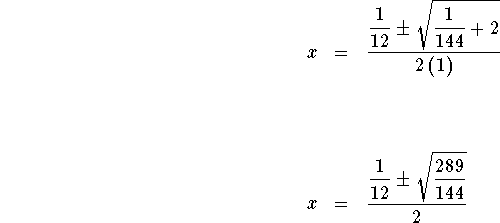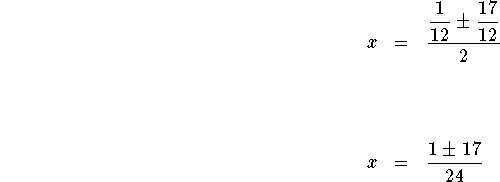 SOLVING QUADRATIC EQUATIONS
SOLVING QUADRATIC EQUATIONS SOLVING QUADRATIC EQUATIONS
SOLVING QUADRATIC EQUATIONS
Note:
 Factoring
Factoring
 Completing the Square
Completing the Square
 Quadratic Formula
Quadratic Formula
 Graphing
Graphing
Solve for x in the following equation.
Example 4: 

Set the equation equal to zero by subtracting ![]() and
and
![]() from both sides of the equation.
from both sides of the equation.
![]()
![]()
![]()
![]()
Method 1: Factoring
Factoring


The left side of the equation is not easily factored, so we will not use this method.
Method 2: Completing the square
Completing the square
Add ![]() to both sides of the equation.
to both sides of the equation.

Add  to both sides of the equation :
to both sides of the equation :
![]()
Factor the left side and simplify the right side :
![]()
Take the square root of both sides of the equation :
![]()
Add ![]() to both sides of the equation:
to both sides of the equation:
![]()
![]()
![]()
Method 3: Quadratic Formula
Quadratic Formula
The quadratic formula is 
In the equation  , a is the
coefficient of the
, a is the
coefficient of the ![]() term, b is the coefficient of the x
term, and c is the constant. Simply insert 1 for a,
term, b is the coefficient of the x
term, and c is the constant. Simply insert 1 for a, ![]() for b, and
for b, and ![]() for c in the
quadratic formula and simplify
for c in the
quadratic formula and simplify
.



![]()
![]()
Method 4: Graphing
Graphing
Graph ![]() (the left side of the equation) and graph y= 0
(the right side of the equation). The graph of y=0 is nothing more than
the x-axis. So what you will be looking for is where the graph of
(the left side of the equation) and graph y= 0
(the right side of the equation). The graph of y=0 is nothing more than
the x-axis. So what you will be looking for is where the graph of ![]() crosses the x-axis. Another way of saying this is that the
x-intercepts are the solutions to this equation.
crosses the x-axis. Another way of saying this is that the
x-intercepts are the solutions to this equation.
You can see from the graph that there are two x-intercepts located at 0.75 and -0.66667. This means that there are two real answers: x=0.75 and -0.66667.
The approximate answers are 0.75 and -0.66667.
Check these answers in the original equation.
Check the solution x=0.75 by substituting 0.75 in the original equation for x. If the left side of the equation equals the right side of the equation after the substitution, you have found the correct answer.



Check the solution x=-0.66667 by substituting -0.66667 in the original
equation for x. If the left side of the equation equals the right side of
the equation after the substitution, you have found the correct
answer.



Since the left side of the original equation is equal to the right side of the original equation after we substitute the value -0.66667 for x, then x=-0.66667 is a solution.
The solutions to the equation  are -0.66667 and .75 .
are -0.66667 and .75 .
If you would like to test yourself by working some problems similar to this example, click on Problem.
If you would like to go back to the equation table of contents, click on Contents.

